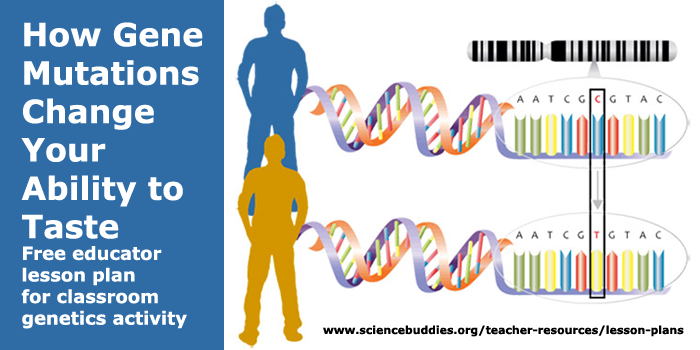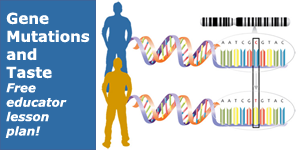Genetic Mutation and Taste

How Gene Mutations Change Your Ability to Taste: Free educator lesson plan for classroom genetics activity
With a new Science Buddies Lesson Plan for grades 6-8, asking students whether or not they taste anything during a controlled taste test is the first step in a fun classroom genetics lesson. The How Gene Mutations Change Your Ability to Taste lesson plan helps teachers introduce students to important genetics concepts (including alleles, genotypes, phenotypes, codons, and mutations) by mobilizing students in the classroom and having them put their own taste buds to the test.
Why a Taste Test?
Students are often curious about their genetic similarities and differences, and taste tests are fun and easy to execute in a classroom setting. The PTC test used in the How Gene Mutations Change Your Ability to Taste activity enables students to quickly sort themselves into three categories (taster, non-taster, and in-between). After figuring out what kind of tasters they are, students begin to investigate to see how the simple manifestation of the ability to taste or not taste can be tracked back to a genetic mutation. As students compare codons for their PTC receptor genes, they search for and identify differences in genetic sequences and draw conclusions about the relationship between genetic variation and the functionality of the resulting proteins. In addition to identifying the genetic mutations, students are challenged to think about why gene mutation matters and what consequences it may have.
The lesson plan is NGSS-aligned to help teachers meet the following Next Generation Science Standards Performance Expectations:
- MS-LS3-1. Develop and use a model to describe why structural changes to genes (mutations) located on chromosomes may affect proteins and may result in harmful, beneficial, or neutral effects to the structure and function of the organism.
- MS-LS3-2. Develop and use a model to describe why asexual reproduction results in offspring with identical genetic information and sexual reproduction results in offspring with genetic variation.
(Note: A chart showing the relevant aspects of NGSS Three Dimensional Learning appears on the summary tab of the lesson plan.)
A Comprehensive Lesson Plan
Teachers without experience in genetics may worry about leading a genetics activity, but Science Buddies' scientist-authored Lesson Plans contain full background material (not available to students) to help familiarize teachers with the science in the activity as well as a guided classroom learning experience. The How Gene Mutations Change Your Ability to Taste Lesson Plan contains background videos that can be assigned to students before or after the in-class experiment, a worksheet for use during the activity, a vocabulary handout, and an assessment quiz.
For more information about Science Buddies Lesson Plans, see Lesson Plans Help Teachers Put Hands-on Science on the Calendar and New NGSS Lesson Plans. View all Science Buddies Lesson Plans here.
More Taste Test and Genetics Science
Students who enjoy this activity may be inspired to learn more about the science of taste or genetics. The following projects may be of interest to students who want to continue the exploration:
Taste:- Battle of the Senses: Taste Versus Smell
- Do You Have the Willpower to Taste Something Sour?
- Do You Love the Taste of Food? Find Out if You Are a Supertaster!
- Measuring Your Taste Threshold
- Old Salty: Does Age Affect the Ability to Detect Salt?
- Are Fingerprint Patterns Inherited?
- From Genes to Genetic Diseases: What Kinds of Mutations Matter?
- Learning Your A, G, C's (and T, too)
- Pedigree Analysis: A Family Tree of Traits
- Drugs & Genetics: Why Do Some People Respond to Drugs Differently than Others?
- X-inactivation Marks the Spot for Cat Coat Color
Categories:
You Might Also Enjoy These Related Posts:
- Spring Science Projects: 26 Science Experiments for Spring
- 6 Picks for St. Patrick's Day STEM
- Why Do Science Projects: Elevate Your Science Classroom: Taking Independent Student Science Projects to the Next Level
- Free science project support in the Ask an Expert forums
- Ahead of the Curve: A Science Teacher's Guide to Proactive Science Project Planning
- 2024 Rubber Band Car Engineering Challenge—10 Steps to Success
- Why Integrate Science Projects in the Classroom—A Teacher's Perspective
- 10 Reasons to Do the Rubber Band Car Engineering Challenge










